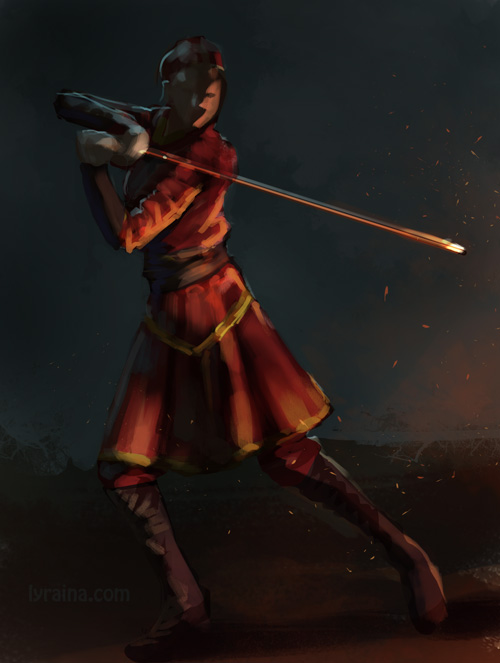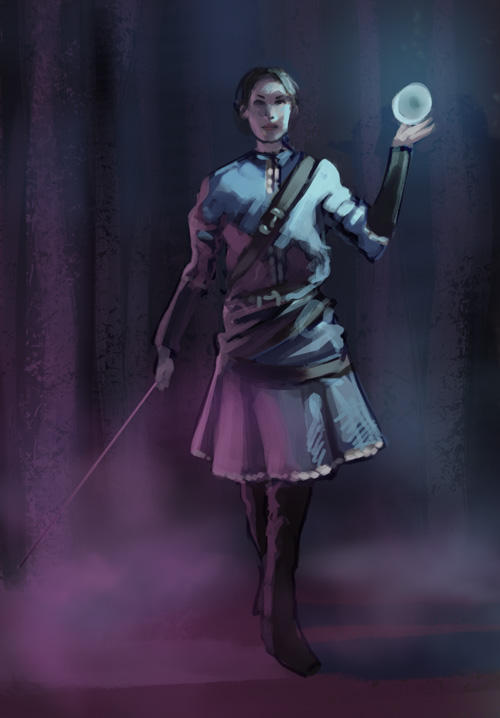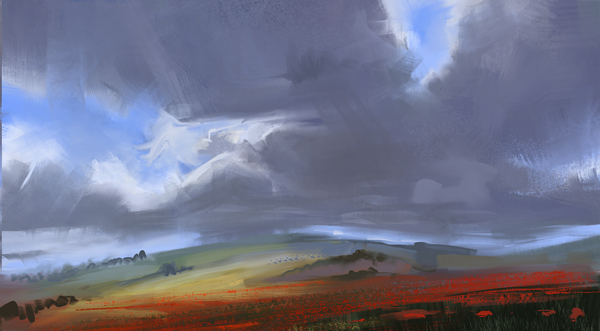05-22-2014, 07:18 AM
JavierP: Thank you! I feel like I'm not using the full potential of the thumbnail process yet, but shooting good reference (with camera, not webcam) really helps a lot.The blog is awesome, didn't know it yet, thanks a lot for letting me know about it! :)
meat: Thank you. Hum, reflection... I kind of neglected that completely, just thought of color, texture, technique... D: And yeah, Nausicaä was a huge experiment :P Not much texture in there though, except for a bit of overpainted rhino leg - but I do plan to experiment more with including photos for a higher level of detail.
Samszym: Thank you! Yeah she's kind of not really looking at the Ohmu, which was the original plan. Realized that way too late though.
Since my last post got eaten by spamblocker and seems not to return, new attempt. Last batch of Gurney studies, you can download the whole bunch of them here if you want.
Illuminated Foreground
...instead of illuminating the middle ground as is common
- details in light
- feels more immediate, closer ?
Snow and Ice
- denser and therefore whiter than clouds or foam
- picks up surrounding colors (shadow often blue from the sky, cloudy = greyer)
- subsurface scattering when backlit, softer, lighter than a solid form
- older snow becomes darker and shinier
Water: Reflection, Transparency
- steep angle: more light refracts into water (we see the ground better)
- shallow angle: more light reflects off the surface
- light object's reflection is slightly darker than the object because not all light gets reflected back to the viewer (like a mirror)
- dirty, illuminated water will lighten dark reflections and make them browner
- wavelets distort and break the reflection
Mountain Streams
- usually clearer, faster, rockier than lowland streams
- wet stones are darker/warmer, more blue when deeper in the water
- farther away more reflections (sky, trees) are visible/color the water
- foam similar to the ocean
- fluctuating water levels can leave rocks darker (also think about what that means for vegetation)
Underwater
- red is absorbed quickest (ten feet), then orange/yellow, leaving a blue cast (also true for underwater flashlight)
- impurities can color the water in different ways: silt/clay (brown), algae (green)
photo study



Dorje Bellbrooks study

Kaladin update. Struggling with the light a bit. The girl (Syl) must be blue, but I may vary on how strong her glow is going to be. I want the mood to be depressed, rainy and dark, so I don't want to overdo the possible orange, although it would be a nice contrast to the blue. Cold light from above (night) could work as well, with a warmer background maybe. Decisions decisions...

meat: Thank you. Hum, reflection... I kind of neglected that completely, just thought of color, texture, technique... D: And yeah, Nausicaä was a huge experiment :P Not much texture in there though, except for a bit of overpainted rhino leg - but I do plan to experiment more with including photos for a higher level of detail.
Samszym: Thank you! Yeah she's kind of not really looking at the Ohmu, which was the original plan. Realized that way too late though.
Since my last post got eaten by spamblocker and seems not to return, new attempt. Last batch of Gurney studies, you can download the whole bunch of them here if you want.
Illuminated Foreground
...instead of illuminating the middle ground as is common
- details in light
- feels more immediate, closer ?
Snow and Ice
- denser and therefore whiter than clouds or foam
- picks up surrounding colors (shadow often blue from the sky, cloudy = greyer)
- subsurface scattering when backlit, softer, lighter than a solid form
- older snow becomes darker and shinier
Water: Reflection, Transparency
- steep angle: more light refracts into water (we see the ground better)
- shallow angle: more light reflects off the surface
- light object's reflection is slightly darker than the object because not all light gets reflected back to the viewer (like a mirror)
- dirty, illuminated water will lighten dark reflections and make them browner
- wavelets distort and break the reflection
Mountain Streams
- usually clearer, faster, rockier than lowland streams
- wet stones are darker/warmer, more blue when deeper in the water
- farther away more reflections (sky, trees) are visible/color the water
- foam similar to the ocean
- fluctuating water levels can leave rocks darker (also think about what that means for vegetation)
Underwater
- red is absorbed quickest (ten feet), then orange/yellow, leaving a blue cast (also true for underwater flashlight)
- impurities can color the water in different ways: silt/clay (brown), algae (green)
photo study



Dorje Bellbrooks study

Kaladin update. Struggling with the light a bit. The girl (Syl) must be blue, but I may vary on how strong her glow is going to be. I want the mood to be depressed, rainy and dark, so I don't want to overdo the possible orange, although it would be a nice contrast to the blue. Cold light from above (night) could work as well, with a warmer background maybe. Decisions decisions...








